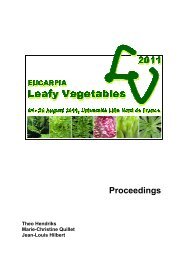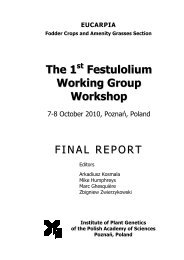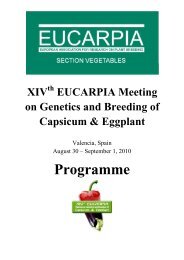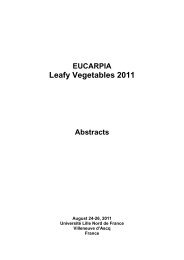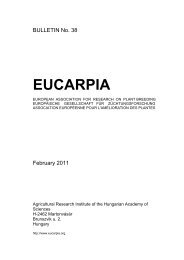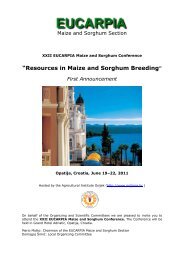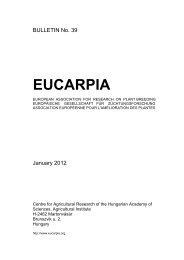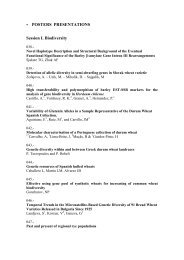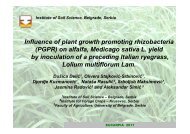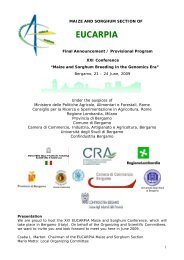Plant breeding for organic and sustainable, low-input agriculture
Plant breeding for organic and sustainable, low-input agriculture
Plant breeding for organic and sustainable, low-input agriculture
You also want an ePaper? Increase the reach of your titles
YUMPU automatically turns print PDFs into web optimized ePapers that Google loves.
Morphological parameters used in the characterization of rye recombinant inbred lines <strong>for</strong><br />
nutrient deficiency in medium<br />
Miłosz Smolik, Rzepka-Plevneš Danuta, Kurek Jadwiga<br />
Department of Horticultural <strong>Plant</strong> Breeding, Agricultural University of Szczecin, Pol<strong>and</strong><br />
Selection using in vitro cultures is useful in identifying genotypes tolerant to biotic <strong>and</strong> abiotic<br />
stresses at seedling <strong>and</strong> cellular stages (Dahleen et al. 1991). According to Rzepka-Plevneš<br />
(1996) selection of cereals <strong>for</strong> tolerance to nutrient deficiency at the seedlings stage is possible,<br />
when length of primary roots <strong>and</strong> number of secondary roots is used as a selection criterion. The<br />
aim of the present studies was to determine the reaction of RILs to the nutritional (N <strong>and</strong> K)<br />
stress in the medium <strong>and</strong> select the lines (RILs) of tolerance of extreme difference to the caused<br />
stress. The 139 RILs (F5) were derived from generation F2 of the hybrid (153/79-1 x Ot 1-3)<br />
obtained from the crossing of two rye inbred lines: high tolerant - 153/79-1 - was derived from<br />
the hybrid (544-7-1-5 x 542-9-1-11) <strong>and</strong> <strong>low</strong> tolerant to nutrient deficiency in the medium - Ot 1-<br />
3 which was derived from old swedish variety Otello. The tolerance of parental rye inbred lines<br />
<strong>and</strong> RILs was assessed by means of the in vitro test (Rzepka-Plevneš et al. 1997). The biometric<br />
measurements of seedlings were made in which the height of coleoptile, the length <strong>and</strong> number<br />
of roots were estimated. These studies, like the in vitro test itself, were carried out using both the<br />
seedlings exposed to the stress <strong>and</strong> the control seedlings. The RILs seedlings which did not differ<br />
significantly as regards the estimated morphometrical parameters were the lines tolerating the<br />
nutritional stress. The lines in which this reaction was significantly different were regarded as<br />
non-tolerant to nutrient deficiency.<br />
The results of the studies showed that within the range of the examined inbred lines there is large<br />
variability both with regard to the height of seedlings, the number <strong>and</strong> length of roots. Rye<br />
seedlings tested on the medium with deficit in N <strong>and</strong> K <strong>for</strong>med on average longer coleoptiles but<br />
shorter germ roots compared to the control seedlings. In regard to the number of roots no<br />
significant differences in relation to the controls were observed. By means of the described<br />
method Rzepka-Plevneš et al. (1999) selected <strong>for</strong>ms of both rye <strong>and</strong> triticale characterised by<br />
high tolerance to nutrient deficiency in the medium. Their agronomic features described in the<br />
experiments did not differ significantly in respect of most traits compared to the control ones.<br />
Hence, in this study this test was used to examine the reactions of the RIL lines to nutrient<br />
deficiency stress. The described RIL lines can be used in <strong>organic</strong> <strong>breeding</strong> as components <strong>for</strong><br />
crossing. Moreover, they are a valuable source of genes of tolerance to abiotic stress. They serve<br />
<strong>for</strong> maintenance of biodiversity <strong>and</strong> can constitute material <strong>for</strong> physiological, biochemical <strong>and</strong><br />
molecular studies.<br />
40




